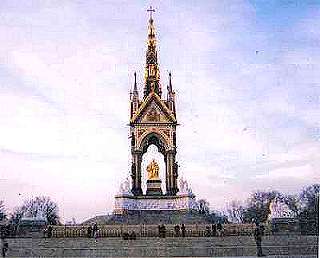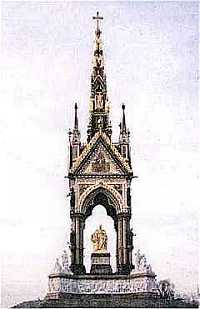
|
||
Albert Memorial London - History of Prince Albert, Queen Victoria and the Memorial
Disorder in the monarchy during the early 18th century was what Queen Victoria had to deal with. Prince Albert married and got closer to the Queen as a confidant and advisor. He began to put the royal house into order. He studied and became as close to the Queen as a husband could. He was to Queen Victoria the king, in all but name. His death broke the heart of the Queen. In his honour, she had the Albert Memorial in London built. A majestic piece of architecture, it was built by the Queen to show how much she loved Albert and was devoted to him. Queen Victoria Comes to the ThroneQueen Victoria came to the throne in 1837 at the age of 18. The British monarchy was in a state of disorder at this time. The disappearance of the monarchy could have been a possibility, as her predecessors George IV and William IV had behaved "irresponsibly". She was quite young and was soon under pressure to marry. Prince AlbertIn February 1840, Queen Victoria chose who she was going to marry. It was a first cousin, Prince Albert of Saxe-Coburg-Gotha. Victoria is said to have been very strong-willed a monarch. She is also said to have been very reluctant to have advisors around her to start with. After Albert had managed to get close enough, closer than just be her husband it would seem, he became her adviser and private secretary. Restoration of Faith in the British MonarchyAlbert took to his position with fervour. Being displeased with the archaic state of the royal household, he reorganized it and also started a study of politics. In 1841, he was appointed head of a commission to encourage the fine arts in Britain. His speeches to the working people showed ability and tact. This, along with a number of Royal country tours began to restore public faith in the monarchy. Albert's Positions, Passions and DeathIn 1847, Cambridge University elected Albert chancellor. His ideas on education helped update and alter the academic program. Albert was interested in agricultural improvements and gardens. He planned and landscaped Victoria's winter home on the Isle of Wight. Late in 1861, Albert's health broke. On the 14th of December 1861, he died of typhoid fever. A Queen with a Broken HeartShe was quoted as being an "utterly broken-hearted and crushed widow of forty-two." She never recovered from her grief at his loss. She withdrew from social activities and dressed in black for many years. She decided to create a memorial for him. One possibility was altering Cleopatra's Needle on the Embankment. She rejected it and would choose something that would later on become called one of the great sculptural achievements of the era. It would combine the talents of some of the most famous sculptors and architects of the period. It was completed in 1868 but the statue of Prince Albert was only added in 1875. Architect and DesignThe principal architect of the memorial was George G. Scott. He got some of his inspiration from a love of miniature medieval shrines. A noteworthy and photo worthy feature are the 169 carved figures on the Frieze of Parnassus. These were designed by H. Armstead and J. Philip. This frieze is at the base of the memorial and goes all the way around it. The SculptorsThe statue of Prince Albert required 4 sculptors. The first one was Carlo Marochetti, a favourite of the Queen. He unfortunately died before finishing the piece. He was replaced by 3 others, two of whom also died prior to its completion. The ArchitectureLooking at the statuary, there are 2 separate groups. 1 of these represents the Continents of Europe, America, Asia and Africa. The other the Industrial Arts and Sciences of agriculture, commerce, engineering and manufacturing. There are several different materials used in the memorial. There are two varieties of granite. Firstly, a red and grey which is used for the pillars supporting the canopy. These pillars are made from individual stones and weigh approximately 17 tons. Secondly, pink granite appears with marble in the pedestal on which the statue sits. The capitals are made with Darley Dale stone. The arches are of Portland stone. Send in your story or comments about the Albert Memorial
|
||

 Ms Lynn Siv sent in a review for us: What a superb monument and to depict the continents! The incredible combination of stones! The best piece, the CROSS on top! Beats any other monument in London. It is tops for me! Truly majestic!
Ms Lynn Siv sent in a review for us: What a superb monument and to depict the continents! The incredible combination of stones! The best piece, the CROSS on top! Beats any other monument in London. It is tops for me! Truly majestic!